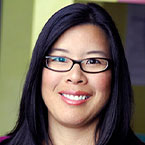By: Laura Jana, MD, FAAP &
Jennifer Shu, MD, FAAP
Did you know that fingernails grow about 0.1 mm each day, and they grow faster in young people, in males, and in the summertime? Well, neither did we until we looked it up, but it certainly doesn't surprise us. While that may not seem like much on the surface, let us assure you that your newborn's nails will keep you busy. Keeping up with them as they continuously grow can be a very demanding task.
As far as we're concerned, the real purpose baby nails serve is to break you into parenthood. They will likely require trimming or filing at least once a week, because long nails on the hands of newborns with little to no control of them predictably result in stray scratches. If you happen to fall behind on your nail clipping, your baby will inevitably remind you (and make you feel guilty) by scratching his face when his nails get too long (or if you leave sharp corners or points when clipping).
Baby mittens: handy, up to a point
Many parents cover their newborn's hands with baby mittens or socks to prevent wayward nails from scratching their faces. As your baby develops over the next several weeks (and you become more skilled at nail clipping), though, it's a good idea to allow babies plenty of time during which they can freely explore with their hands. If scratches continue to be a problem, we suggest limiting covered time to when your baby is sleeping.
The baby mani-pedi
A handful of parents are intimidated by the prospect of having to cut their baby's nails and would probably opt for a professional manicure-pedicure if only it was generally available. No such luck.
If you're lucky, your hospital nurse will be able to help demonstrate the correct technique, but some hospitals discourage their personnel from doing so (we can only presume because any unintentional injury may be a liability problem). And while we aren't exactly recommending it (or admitting to doing it ourselves), we're well aware that some parents opt to bite or peel off their newborn's nails rather than fiddle with clippers or scissors. Be aware, however, that doing so can potentially lead to infection.
Newborn nail-trimming tips
Because clippers and scissors can trim nails in a more controlled fashion, you'll be much better off using one or the other (or both) or simply using a nail file to keep things under control. For best results:
- Trim or file your baby's nails when she's asleep and her hands are less of a moving target.
- Push down on the fingertip skin so you can get the clipper or scissors around both sides of the nail and avoid cutting your baby's finger (or toe).
- Then, just as a professional manicurist would,
finish off any sharp or rough edges with an emery board and…voilà!
Not so bad after all, once you get the hang of it.
More information
First Month: Physical Appearance and Growth
Bathing & Skin Care
About the authors
 Laura A. Jana, MD, FAAP, is a pediatrician and mother of 3 with a faculty appointment at the Penn State University Edna Bennett Pierce Prevention Research Center. She is the author of more than 30 parenting and children's books and serves as an early childhood expert/contributor for organizations including the Maternal and Child Health Bureau, Primrose Schools, and US News & World Report. She lives in Omaha, NE. Laura A. Jana, MD, FAAP, is a pediatrician and mother of 3 with a faculty appointment at the Penn State University Edna Bennett Pierce Prevention Research Center. She is the author of more than 30 parenting and children's books and serves as an early childhood expert/contributor for organizations including the Maternal and Child Health Bureau, Primrose Schools, and US News & World Report. She lives in Omaha, NE.
 Jennifer Shu, MD, FAAP, is a practicing pediatrician, author, and mom in Atlanta. Dr. Shu is co-author of Heading Home with Your Newborn and Food Fights. A frequent guest on national and local television, radio, and web-based programs, she is serves as medical editor for HealthyChildren.org, is the Living Well health expert for CNN.com, contributes medical information to BabyCenter and WebMD.com, and serves on the Parents magazine advisory board.
|